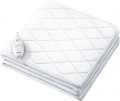Power levels
The number of power levels (adjustments) provided in the device.
The more levels provided in the design (with the same maximum power) — the more precisely you can adjust the heating to your preferences. On the other hand, the abundance of adjustments affects the complexity and price of the device, despite the fact that there is not always a need for this. So, for electric sheets (see "Type"),
2 – 3 modes are quite enough — intensive for preheating and one, less often two workers. On the other hand, the opposite situation occurs —
6 or even more power levels.
Operating time
The operating time is the time until the device auto-shutdown. Therefore the time during which a sheet or blanket works on heating. There are models with an adjustable shutdown timer, which allows you to set the required time for the device to automatically turn off.
Washing
Washing method allowed for the product.
Modern heating pads can be designed for both
manual and
machine wash. Note that both of these terms are rather conditional. So, “manual” washing can be carried out both manually and in an activator-type machine (semi-automatic) and even in an automatic “washer” if it has a special manual/delicate washing programme. Machine washable items can also be washed by hand.
Note that both options may provide specific requirements for washing conditions — in particular, a temperature limit. Therefore, before washing the heating pad, you must carefully study the corresponding section of the instructions anyway.
Power consumption
Rated power consumed by the heater during operation.
Technically, other things being equal, a more powerful device will heat up faster and heat more greatly, but its energy consumption will also be higher. However, in fact, this parameter is of secondary importance: manufacturers select power in such a way as to provide the heating pad with the necessary performance. So paying attention to power makes sense mainly when comparing and only in cases where the differences are significant — for example, if one model consumes 100 W, and another of similar size only 60 W.

